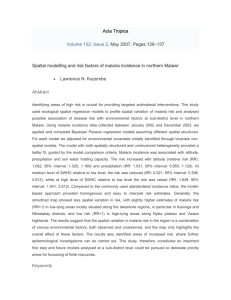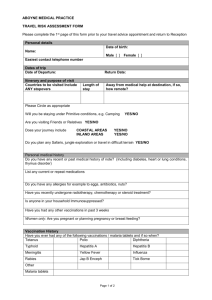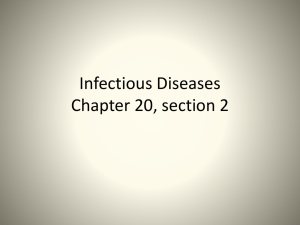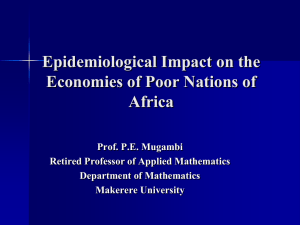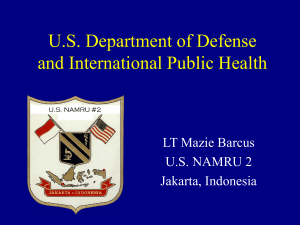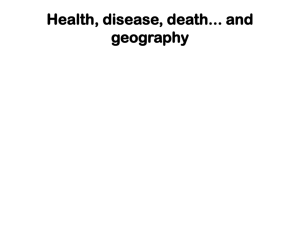Isaac Rowner
advertisement
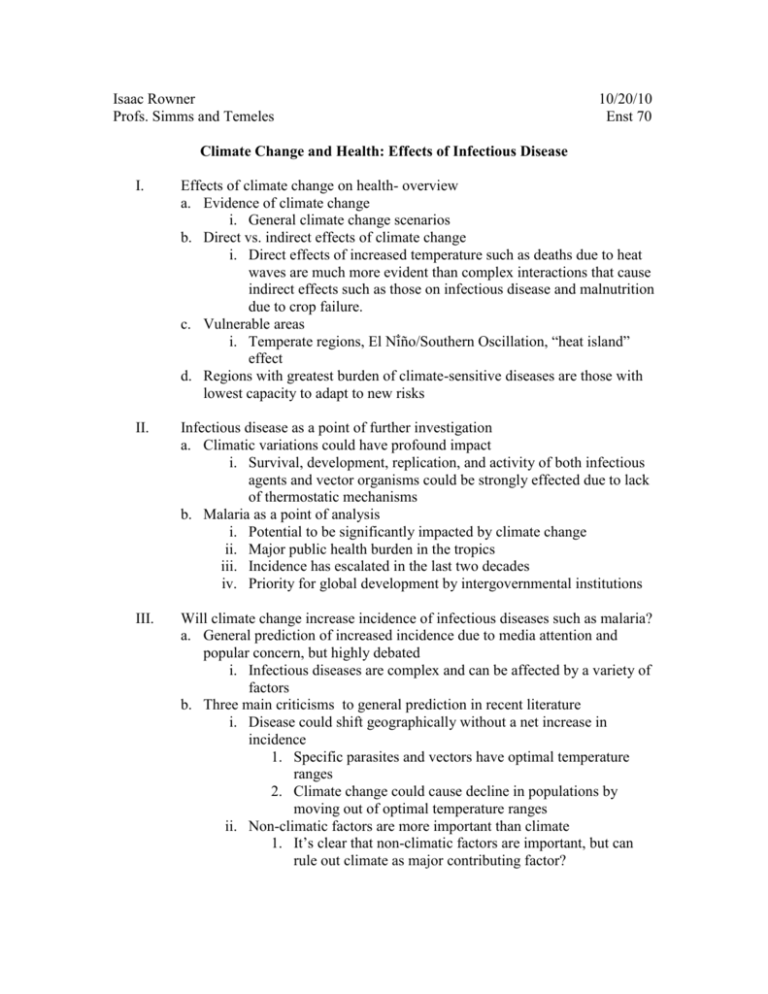
Isaac Rowner Profs. Simms and Temeles 10/20/10 Enst 70 Climate Change and Health: Effects of Infectious Disease I. Effects of climate change on health- overview a. Evidence of climate change i. General climate change scenarios b. Direct vs. indirect effects of climate change i. Direct effects of increased temperature such as deaths due to heat waves are much more evident than complex interactions that cause indirect effects such as those on infectious disease and malnutrition due to crop failure. c. Vulnerable areas i. Temperate regions, El Ni̐ ño/Southern Oscillation, “heat island” effect d. Regions with greatest burden of climate-sensitive diseases are those with lowest capacity to adapt to new risks II. Infectious disease as a point of further investigation a. Climatic variations could have profound impact i. Survival, development, replication, and activity of both infectious agents and vector organisms could be strongly effected due to lack of thermostatic mechanisms b. Malaria as a point of analysis i. Potential to be significantly impacted by climate change ii. Major public health burden in the tropics iii. Incidence has escalated in the last two decades iv. Priority for global development by intergovernmental institutions III. Will climate change increase incidence of infectious diseases such as malaria? a. General prediction of increased incidence due to media attention and popular concern, but highly debated i. Infectious diseases are complex and can be affected by a variety of factors b. Three main criticisms to general prediction in recent literature i. Disease could shift geographically without a net increase in incidence 1. Specific parasites and vectors have optimal temperature ranges 2. Climate change could cause decline in populations by moving out of optimal temperature ranges ii. Non-climatic factors are more important than climate 1. It’s clear that non-climatic factors are important, but can rule out climate as major contributing factor? iii. To predict increasing disease transmission models must show that transmission rate exceeds a specific threshold (R0 >1) 1. Historical records of the distribution of malaria include large geographical areas in which the projected values of R0 were less than one 2. If the initial outbreak is caused by the simultaneous arrival of a large number of infected hosts disease could still invade IV. Projections of future malaria prevalence due to climate change a. Rogers and Randolph (2000) i. “medium-high” climate scenario predicted 23 million additional people living in malarious areas, while “high” scenario predicted 25 million fewer people ii. Fragility of the relationships between parasite and vectors and climatic conditions iii. Statistical versus biological models b. Tanser et al. 2003 i. Using different climate change scenarios estimated a 5-7% potential increase in malaria distribution due to a prolonged transmission season ii. Estimated that a large proportion of increased distribution will be seen in areas of existing transmission and will be mainly altitudinal c. Pascual et al. (2006) i. Analyzed a long term data set of four East African Highland sites where there has been a marked resurgence of malaria and showed a significant warming trend at all four sites ii. Using a dynamical model they also found that even small changes in the climate signal can dramatically amplify mosquito abundance 1. Significant public health implications for spread of disease to new regions d. Lieshout et al. i. Used different climate change scenarios to find that in East Africa, central Asia, and areas around the southern limit of the distribution in South America there will be additional populations at risk of contracting malaria ii. Employed a new method of for describing vulnerability according to current vulnerability and malaria control status and estimated that in countries that currently have a limited capacity to control the disease will have additional populations at risk by the 2080s. V. Economic and social costs of climate change on health a. Effects are generally externalities that are unprecedentedly large, complex, and uncertain b. Costs 1. DALYs, 2. Disproportionate effect on youngest generation c. Models to estimate costs d. Link between economic and social costs i. Cyclical- increased prevalence leads to decreased economic productivity leads to increased inability to address problem VI. What can we do? – possible solutions a. Most likely best approach is to attack each issue individually i. Coordinate anti-malarial programs in the most vulnerable regions including those where there is a predicted potential increase in transmission ii. Push forward policy initiatives to mitigate emissions of greenhouse gases VII. Policy initiatives a. The Intergovernmental Panel on Climate Change comprised of top climate scientists from around the globe has reached a consensus that human activities have contributed significantly to global climate change i. The United States has refused to join concerted international efforts, such as the Kyoto protocol to curb human activities contributing to climate change ii. Policy responses so far have had little or no impact on the buildup of emissions. b. Consistent adherence to interacting journalistic norms has contributed to barriers in the coverage of anthropogenic climate change science (Boykoff and Boykoff 2007) c. Framing of issue i. Possibly presenting more evidence of direct human effects of climate change will spur public action

